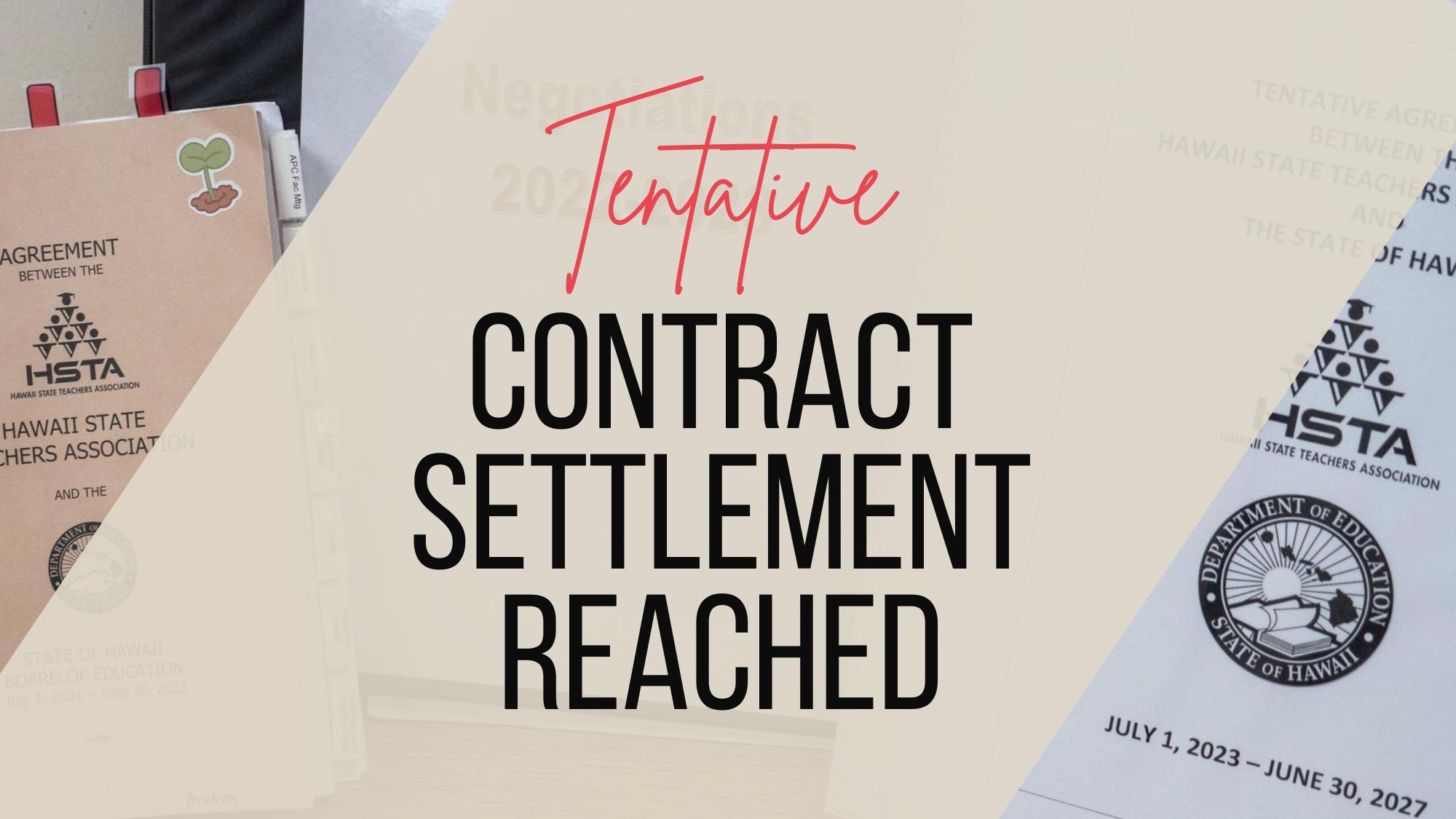In-person ratification vote scheduled for April 26
Updated: April 24, 2023
The Hawaiʻi State Teachers Association is pleased to announce that we reached a tentative settlement late Friday, April 14, with the State of Hawaiʻi and the Board of Education for a new four-year contract from July 1, 2023, through June 30, 2027.
HSTA’s Negotiations Committee recommended the agreement to the Board of Directors, which voted to approve it during special meetings Saturday, sending it to the bargaining unit membership for ratification. The HSTA Board unanimously recommends members vote yes on approving the tentative agreement.
The agreement includes salary increases in each of the next four years as well as increases in the employer contribution to health premiums, supplementary pay, and changes in the salary structure, including the creation of a Class VIII and streamlining and expanding instructor pay on the schedule. Under the agreement, educators who did not benefit from the compression fix will receive a one-time $3,000 payment next school year. Overall, this package will increase the average teacher salary by over $10,000 without factoring in the newly-added opportunity to reclassify to Class VIII which approximately one-third of our bargaining unit has been waiting for. The parties have also agreed to permanently incorporate 21 hours of job-embedded professional development into the contract. Additional improvements in teacher working conditions, travel, assignments and transfer, due process, and teacher protections are included in the agreement. The agreement also calls for the creation or continuation of a series of workgroups to address important issues in career and technical education (CTE), Hawaiian education, transfers, leave, student discipline, and English learners.
“We really have not had a chance to make substantive changes to contract language since 2013,” said HSTA President Osa Tui, Jr. “This round of bargaining was the most collaborative I’ve experienced in my decade of negotiations with the employer. We’re also extremely grateful to Gov. Josh Green, who joined us on the last day of bargaining and actively helped to clear some of the logjams that remained.
“This tentative agreement, coming on the heels of major wins in fixing compression, will put our members in a much better place than they were just a year ago,” Tui continued. “This includes compensation for those who did not receive compression adjustments, substantially raising the pay of emergency hires, raising supplementary pay amounts, and at long last, establishing Class VIII on the salary schedule that many thought impossible!”
“While the state had been predicting a budget surplus, the Council on Revenues’ revised forecast slashed projections by $328 million, affecting key funding decisions. Also, a number of key education-related initiatives, including universal pre-K, developing teacher workforce housing, and state teacher tax credits will take considerable resources to fund,” Tui said.
“We had asked for significantly larger raises, but understand that the state has less money to pay for numerous key priorities in addition to addressing teacher compensation, such as creating affordable housing, bringing down the state’s high cost of living and preserving our natural resources,” Tui added.
“Ultimately, the salary improvements we’ve secured and the many other improvements to contract language will benefit the public school students of Hawaiʻi who should see improved recruitment and retention of highly qualified educators to our classrooms,” said Tui.
Diane Mokuau, HSTA Negotiations Committee chair, said, “Your Negotiations Team spent many days away from their students and on weekends and holidays not only to earn hard-fought gains for this contract but also to resist a number of takebacks from the employer.”
Some of the items the employer unsuccessfully tried to get HSTA to agree to included:
- A 2-year contract with salary increases of 3% each year with no step movements, which would have caused even more salary compression.
- Thirty credits to move from Class VII to Class VIII, when all other reclassification movements are 15 credits.
- Forcing non-classroom teachers to substitute purely at the principal’s discretion.
- Having teachers administer student medications.
- Not providing sick leave up front and moving to an accrual system, and prohibiting any leave adjacent to school breaks.
- Not renewing a number of memoranda of understanding, including supplementary pay for grade level/department chairs and others, and continuing to work on issues related to the Teacher Assignment and Transfer Program.
- Allowing principals to determine the manner and time at which teachers check in to indicate presence.
- Sabbatical leave for no more than, instead of at least, 50 teachers subject to funding.
- Making permanent the contract procedures around emergency closures instead of just being a pilot project.
- Mandating that HSTA provide 90 days advance notice to release teachers for union business during work days, instead of the current five days.
While the Negotiations Team tried to secure as many items in HSTA’s initial proposals as possible, not all items survived which is the nature of bargaining. HSTA will continue to advocate for those priorities that did not make it into the tentative agreement.
What happens next: webinar April 24, ratification vote April 26
We will hold an informational webinar with HSTA President Osa Tui and Chief Negotiator Andrea Eshelman on Monday, April 24, at 4:30 p.m. This session will be recorded and posted on our website. Please stay tuned for more information on how to attend the webinar. If you have any questions in the meantime, please submit them via contact form.
An in-person ratification vote on the contract will occur for all who are covered by the Bargaining Unit 05 contract on Wednesday, April 26, from 3 to 6 p.m. at various locations across the state.
Chair Mokuau said, “I am so proud of our HSTA Negotiations Team and staff for what they were able to bring forward to our members and hope that you will all vote ‘YES’ on April 26! Please wear your new red HSTA shirt (or any red attire) to show solidarity.”
*These documents were updated Monday, April 24, at 6 p.m.
You may also request to vote by absentee ballot or, as a new option, request to vote at an alternate voting site. Call HSTA at (808) 833-2711 or click the link listed under “Alternate Vote Site Request” to submit your request no later than Friday, April 21, at 5 p.m. Upon processing, you will receive an email confirmation.
Initial results will be released the evening of April 26, with absentee ballots counted and a final vote tally released on May 4.
Mahalo for standing strong and for all that you do for Hawaiʻi’s public school students. We’ll see you at your voting site on April 26!

Your 2023 HSTA Negotiations Team
From left: Kathy Shibuya, Committee Member (Kauaʻi Chapter); Colleen Bird, HSTA Negotiations and Research Specialist; Jenne Olayon, Committee Vice Chair (Hilo Chapter); Logan Okita, HSTA Vice President; Osa Tui, Jr., HSTA President (back); Diane Mokuau, Committee Chair (Molokaʻi Chapter) (front); HSTA NEA Director Aaron Kubo (present to support the team); David Negaard, Committee Member (Maui Chapter); Andrea Eshelman, HSTA Chief Negotiator and Deputy Executive Director. Not pictured: Lisa Morrison, HSTA Secretary-Treasurer; Ann Mahi, HSTA Executive Director.
Summary of changes
On April 14, 2023, the Hawaiʻi State Teachers Association (HSTA), State of Hawaiʻi and Board of Education reached a tentative agreement on the next HSTA contract. This section includes information on the settlement. You can download a PDF of this overview here.
Additional Compensation
Working Conditions and Employee Rights

